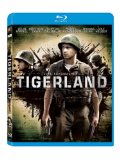“My father said the army makes all men one, but you never know which one.”
There have been a lot of movies about Vietnam over the years. Some are quite political, while others try to capture the sheer horror of war…any war. It’s been long enough now that there are even lighter works about the conflict. But this might just be the smartest film about the war ever made, because it never actually goes to Vietnam.
“Fort Polk, Louisiana – Sept. 1971.”
Instead of taking you to the jungle battlefields that we’ve seen time and time again, Joel Schumacher delivers a much more compelling story that does a better job of presenting the dread of the war without ever leaving the United States. Instead we join a group of training soldiers, most of them young draftees, as they enter their final phase of infantry training. They will spend their final week before being shipped out at a place in Louisiana called Tigerland. It is this remote area of Fort Polk where the army has created the battlefields of “The Nam” to simulate conditions to better train the soldiers. Everything about life in Vietnam was recreated here, from live ammunition fire buzzing around you to a mock Vietnam village where the soldiers trained for rooting out VC infiltrators. It’s all from the real-life experiences of Ross Klavan, who trained at Tigerland in 1971. His book and screenplay provide the meat for the film.
“Well, the fellas say that if you don’t wanna go to Nam, you better pray to Jesus or talk to Roland Bozz.”
Of course this is a fictional account. We get to know Bozz (Farrell). He’s been trying to find a way to get drummed out of the army before he can get shipped out to Vietnam. His efforts have only landed him a lot of time in the stockade and the dislike of the brass who run the base. As Bozz gets to know his fellow recruits, he begins to feel for them, something he resists at first. He doesn’t want to start liking someone who is liable to be dead within a year. But he soon discovers there are kids here that have no business going to war, and he helps them find loopholes to get out. That makes him even more trouble for the brass. All the while he has his own escape planned. But things just never go to plan when you’re training to go to Vietnam in 1971.
The strength of this film can be found completely in some incredibly strong performances. Even though the film never did get a wide release, it was a breakout performance for the young Colin Farrell. He manages to show a wonderful range of emotions under rather brutal filming conditions. All the while he’s doing a great job of hiding his Irish accent and convincingly sounding like a Texan. I won’t say he doesn’t slip from time to time, but the performance never slips once. The movie might not have been a hit, but Farrell made the most of a perfect opportunity to show just what kind of range he had. We’re talking a pretty solid supporting cast with the likes of Clifton Collins, Jr. who does a superb job of the mentally deteriorating Miter.
The film has a compelling sense of authenticity throughout. Schumacher takes us into these simulated jungles so that we begin to really feel what these guys are going through. This may not be the war itself, but every one of these trainees know what comes next, and Schumacher does a perfect job of getting that dread and fatalism on the screen. The camera isn’t a casual observer from a distance. He gets right into the faces of these young recruits. You are down-and-dirty with them every step of the way. It’s an engaging film that really did deserve a box office release. Now’s your chance to check out the best Vietnam War film you never saw.
Video
Tigerland is presented in its original aspect ratio of 1.85:1. The 1080p image is arrived at with an AVC MPEG-4 codec at an average 30 mbps. The conditions portrayed here are harsh so it’s fortunate that we have been given a rather nice high-definition image presentation. Black levels are essential and allow you to see tremendous detail in the night and heavy rain sequences. You’ll get not a lot of color, but great separation of shades. Textures make this a very visceral experience. Sharpness and detail capture the emotional performances perfectly.
Audio
The DTS-HD Master Audio 5.1 is a bit mixed here. Don’t expect Saving Private Ryan surrounds. There are some firefight moments where the surrounds are used a bit, but this film lives mostly in the front speakers. The sub gives you some indication that it is there, but you won’t be shaking the room a heck of a lot. Dialog comes through, and the sound has no real flaws to speak of.
Special Features
All in Hi-Def.
The Real Tigerland: (21:44) Descriptions of the real training camp from soldiers who were there.
Joel Schumacher – Journey To Tigerland: (10:07) The director talks about his own path to the film. The feature also looks at casting and the story itself.
Ross Klavan – Ode To Tigerland: (10:55) Some thoughts from the writer.
Casting Sessions With Colin Farrell: (6:29) There are three audition segments that can be played separately or with a play all option.
Trailers and Television Spots
Final Thoughts:
The real Tigerland was intended to prepare these soldiers for real combat in the hopes it will help keep them alive. It worked. The recruits who went through Tigerland had the highest survival rates in the war. This movie captures the why. It was a brutal place to be, perhaps worse for some than the actual war turned out to be. One run of this film and I think you’ll understand. An ideal film for anyone who “wants to go for the experience“.




